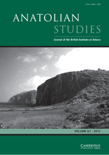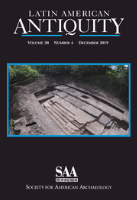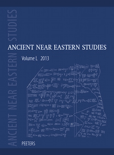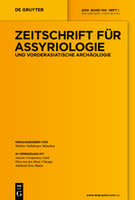
Vestnik Drevnei Istorii-Journal of Ancient History
metrics 2024
Fostering Scholarly Dialogue Across Time
Introduction
Vestnik Drevnei Istorii - Journal of Ancient History, published by the esteemed Russian Academy of Sciences and the State Academy of Humanities (GAUGN), plays a pivotal role in the interdisciplinary field of ancient studies. Fostering scholarly discourse since 2016, this journal is positioned at the crossroads of archaeology, classics, history, and linguistics, as evidenced by its impressive 2023 ranking in multiple categories, including Q1 in Classics and Q2 in History. Although not open access, it serves as a critical resource for researchers, professionals, and students interested in deepening their understanding of ancient societies and cultures. With a reputation for rigor and a commitment to advancing knowledge, the journal aims to disseminate innovative research that sheds light on the complexities of ancient civilizations and their contributions to contemporary society. Current issues and a wealth of archived articles are available for exploration, fostering a rich environment for scholarly engagement.
Metrics 2024
 0.15
0.15 0.20
0.20 0.10
0.10 5
5Metrics History
Rank 2024
Scopus
JCI (Web Of Science)
Quartile History
Similar Journals

Anatolian Studies
Showcasing Innovative Discoveries in Anatolian StudiesAnatolian Studies, published by Cambridge University Press, stands as a premier forum for research in the fields of archaeology, cultural studies, and history. Established in 1951, this esteemed journal has consistently contributed to the academic discourse surrounding the rich and multifaceted history of Anatolia, earning its place in the Q1 category across multiple disciplines. With a notable impact factor reflected in its Scopus rankings, it ranks among the top journals in its fields: 78th in History, 155th in Cultural Studies, and 55th in Archaeology, showcasing its significant influence and recognition. This journal serves as an invaluable resource for researchers and scholars seeking to delve into the intricacies of Anatolian heritage, providing a platform for innovative research and critical discussion within the academic community. While it currently does not offer open access, Anatolian Studies continues to enrich scholarly resources and advance knowledge within its key areas of focus.

GYMNASIUM
Illuminating Classical Insights for Educational InnovationGYMNASIUM, published by Universitätsverlag C Winter Heidelberg GmbH, is an academic journal dedicated to the fields of Classics and Education. Since its inception in 1970, the journal has served as a platform for scholarly discourse, focusing on the intersection of classical studies and educational methodologies. Despite its discontinuation from Scopus coverage post-2021, GYMNASIUM remains an important resource for researchers, professionals, and students, fostering a deeper understanding of ancient texts and their relevance in contemporary educational frameworks. Current rankings place the journal in the Q4 quartile in both Classics and Education categories, reflecting its niche yet significant contribution to these fields. Researchers can access the journal's past issues through various academic libraries in Germany, enhancing interdisciplinary study and promoting scholarship across broader educational horizons.

Journal of Ancient History and Archaeology
Exploring the Depths of Ancient CivilizationsJournal of Ancient History and Archaeology is a premier, open-access academic journal published by MEGA PUBLISHING HOUSE since 2014, dedicated to exploring the rich tapestry of ancient civilizations and archaeological discoveries. With ISSN 2360-266X, this journal has made significant strides in the field, achieving elevated rankings across multiple categories, including Q1 in Classics and Q2 in History as of 2023. Positioned in Romania, the journal serves an international audience of researchers, professionals, and students who seek to disseminate and access influential scholarship in ancient history and archaeology. As a prominent resource within the Scopus rankings, it reflects a robust commitment to advancing knowledge through quality research, making it a vital platform for the sharing and discussion of innovative ideas and methodologies. The journal covers a wide array of topics related to ancient societies, enhancing our understanding of their cultural, historical, and archaeological significance.

Cahiers Mondes Anciens
Fostering Dialogue on Ancient CivilizationsCahiers Mondes Anciens is a distinguished Open Access journal dedicated to advancing the field of ancient studies, encompassing a wide array of disciplines such as archaeology, history, and cultural heritage. Published by CAHIERS MONDES ANCIENS, based in Paris, this journal has been providing seamless access to groundbreaking research since its inception in 2010, embodying a commitment to democratizing knowledge within the academic community. With an ISSN of 2107-0199, Cahiers Mondes Anciens offers a platform for researchers and scholars to share innovative findings, critical analyses, and interdisciplinary approaches that enrich our understanding of the ancient world. The journal is renowned for its rigorous peer-review process, ensuring the highest standards of scholarship. By fostering a vibrant community of academics, it plays a crucial role in the ongoing discourse surrounding ancient civilizations, making it an essential resource for professionals, students, and enthusiasts alike.

LATIN AMERICAN ANTIQUITY
Documenting the Echoes of Ancient Civilizations in Latin AmericaLATIN AMERICAN ANTIQUITY is a prestigious journal published by Cambridge University Press, focusing on the archaeology and history of Latin America. With an impressive impact factor reflecting its critical role in the academic community, this journal exemplifies excellence in research, landing in Q1 across multiple categories, including Archaeology and History, as per the 2023 category quartiles. The journal's scope covers a broad range of topics related to pre-Columbian cultures, ancient civilizations, and historical developments, making it essential reading for researchers, professionals, and students keen on exploring the rich tapestry of Latin American heritage. Although it is not an open-access publication, LATIN AMERICAN ANTIQUITY remains a vital resource for those dedicated to advancing knowledge in this dynamic field. With its commitment to scholarly rigor and a strong ranking in Scopus, it serves as a cornerstone for academic dialogue and investigation.

Gerion-Revista de Historia Antigua
Unlocking the Mysteries of Our Historical LegacyGerion-Revista de Historia Antigua is a prestigious academic journal published by UNIV COMPLUTENSE MADRID, SERVICIO PUBLICACIONES. Since its inception in 1983, this Open Access journal has been a vital platform for researchers and scholars in the fields of Archaeology, History, and Classics. Based in Madrid, Spain, the journal promotes rigorous scholarship and dissemination of knowledge covering a broad spectrum of ancient history and artifacts. With its impressive quartile rankings—Q1 in Classics and Q2 in both History and Archaeology—Gerion demonstrates a strong commitment to academic excellence, boasting a respectable presence within Scopus rankings. Researchers will find a collaborative space here, as the journal aims to support interdisciplinary dialogue and foster a deeper understanding of ancient civilizations. With its dedicated approach to quality and accessibility, Gerion is essential for anyone engaged in the study of our historical past, making it a valuable resource for students, professionals, and academics alike.

Ancient Near Eastern Studies
Advancing Scholarship in the Heart of Ancient HistoryAncient Near Eastern Studies, published by PEETERS in Belgium, is a distinguished journal dedicated to the exploration and scholarship of the rich cultural and historical tapestry of the ancient Near East. With a focus on interdisciplinary research, this journal invites contributions across various fields including Archeology, History, Classics, Literature and Literary Theory, and Visual Arts and Performing Arts. As evidenced by its robust performance in the 2023 category quartiles, ranking Q1 in Classics and Q2 in History, this journal is recognized for its academic rigor and relevance, making it an integral platform for researchers, professionals, and students alike. Although currently not open access, it provides indispensable insights into research trends and theoretical frameworks that advance our understanding of ancient civilizations. With its ISSN 1378-4641 and E-ISSN 1783-1326, Ancient Near Eastern Studies continues to foster scholarly communication and engagement in this vital area of human history.

Zeitschrift fur Assyriologie und Vorderasiatische Archaologie
Pioneering Research in Assyriology and ArchaeologyZeitschrift für Assyriologie und Vorderasiatische Archäologie, published by WALTER DE GRUYTER GMBH, is a distinguished journal in the field of archaeology, focusing on the rich histories of the ancient Near East and Assyrian studies. Established in 1886, this journal has a venerable tradition of contributing to scholarly discourse, continuously curating impactful research that positions it within the Q2 quartile in the domains of Archaeology and Arts and Humanities as of 2023. With an impressive ranking of #101 out of 413 in Arts and Humanities and #98 out of 354 in Social Sciences within Scopus, the journal serves as a vital resource for researchers, professionals, and students alike. Although it operates under a subscription model, the journal's extensive coverage—from its inception to the present day—ensures a comprehensive exploration of archaeological methodologies, discoveries, and theoretical frameworks. The journal's aim is to advance the understanding of the ancient civilizations of the Near East and to foster scholarly communication across international platforms, making it an essential venue for contemporary archaeological research.

HISTORIA-ZEITSCHRIFT FUR ALTE GESCHICHTE
Transforming Perspectives: Interdisciplinary Dialogues on Ancient NarrativesHISTORIA-ZEITSCHRIFT FUR ALTE GESCHICHTE, published by FRANZ STEINER VERLAG GMBH, is a premier open-access journal dedicated to the rigorous exploration of ancient history, bridging critical insights from classics and historical studies since its inception in 1976. This distinguished publication, recognized with a Q1 ranking in both Classics and History for 2023, serves as a vital platform for researchers, professionals, and students alike, fostering interdisciplinary dialogue and advancing scholarship in the field. With a notable standing in Scopus, ranking #12 out of 170 in Classics and #288 out of 1760 in History, it addresses pivotal topics and emerging trends relevant to contemporary historiography. The journal’s commitment to open access, established in 2010, ensures that knowledge is widely disseminated, cultivating an inclusive academic community. For those dedicated to uncovering the nuances of ancient civilizations, HISTORIA remains an indispensable resource that significantly contributes to the global discourse on our historical heritage.

Eirene-Studia Graeca et Latina
Connecting Past and Present through ResearchEirene-Studia Graeca et Latina, ISSN 0046-1628, is a prominent academic journal published by the Institute of Classical Studies, Academy of Sciences of the Czech Republic. Focusing on the fields of Classics, Linguistics, and Archaeology, this journal serves as a vital platform for scholarly discourse and research dissemination since its inception in 2002. Although it operates under a traditional access model, the journal has established itself within the academic community, evidenced by its placement in the Q4 category across multiple disciplines in 2023. This includes significant rankings in areas such as Archaeology and Language and Linguistics, where it finds itself within the 27th to 16th percentiles of its respective categories. Eirene aims to foster the advancement of research in the Humanities, providing a rigorous forum for scholars and practitioners interested in classical studies. Its contribution to the academic landscape is essential for those who aspire to explore the depths of ancient languages, cultures, and methodologies, making it a valuable resource for researchers, professionals, and students alike.